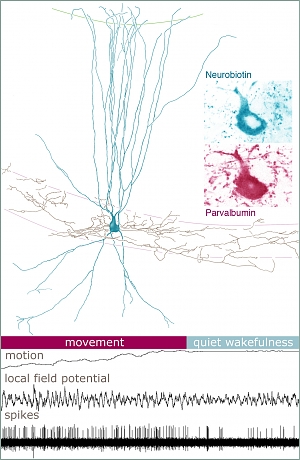Damien Lapray and his collaborators at Oxford and Vienna explored how the firing rate and patterns of GABAergic interneurons is adjusted in the neuronal network to ongoing behaviour in freely moving rats. They used novel innovative technology to record and label single GABAergic neurons while the rat moved, slept or just kept quiet in a small arena. Recorded parvalbumin–expressing basket interneurons innervate somata and proximal pyramidal cell dendrites, whereas nitric–oxide–synthase– and neuropeptide–Y–expressing ivy cells provide synaptic and extrasynaptic dendritic modulation. Basket and ivy cells showed distinct spike timing dynamics, firing at different rates and times during theta and ripple oscillations. Basket but not ivy cells changed their firing rates during movement, sleep and quiet wakefulness, suggesting that basket cells coordinate cell assemblies in a behavioral state–contingent manner, whereas persistently–firing ivy cells might control network excitability and homeostasis. Different interneuron types provide GABA to specific subcellular domains at defined times and rates, thus differentially controlling network activity during behavior.
